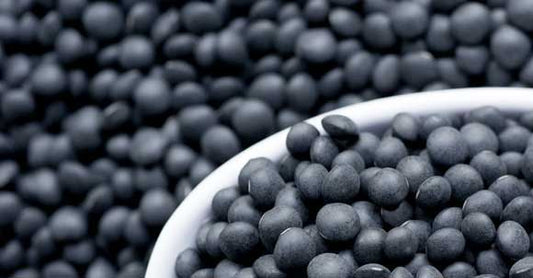Pulses
about Pulses: click here to read more
Pulses are grain legumes that are an annual crop with one to twelve seeds within a pod. It includes beans, lentils and legumes.
Pulses are the edible seeds of leguminous plants (plants from the family Fabaceae) that are harvested specifically for their dry seeds. Examples of pulses include lentils, chickpeas, beans, peas, and soybeans. Pulses are considered a type of legume, but not all legumes are pulses. Pulses refer only to the dried seeds, whereas the term "legume" also includes fresh seeds, pods, and plants.
Pulses, like all legumes, have seeds that consist of two halves, known as cotyledons, which store nutrients.
These seeds are encased in a protective outer covering, called the seed coat. When pulses are harvested, the outer coat is typically removed, leaving behind the seed, which is rich in protein, fiber, and other essential nutrients.
Pulses grow inside pods, which contain the seeds. These pods are typically split open at harvest to release the seeds. Unlike many other plants, pulses are harvested when their seeds are dry, which helps preserve them for long-term storage.
Pulses also have a taproot system, where the primary root grows deep into the soil, with smaller lateral roots. This taproot allows pulses to be relatively drought-tolerant compared to other crops. Additionally, the root nodules of pulses contain nitrogen-fixing bacteria, which help the plants absorb nitrogen from the air, enriching the soil's fertility.
Pulses share many similarities with other legumes, as they belong to the larger legume family (Fabaceae), which includes plants like beans, peas, and peanuts. Like other legumes, pulses have the ability to fix nitrogen in the soil, benefiting the ecosystem by enriching it with nitrogen.
Additionally, both pulses and other legumes grow inside pods, with their seeds typically being harvested when dry.
However, there are notable differences. Pulses are specifically harvested when their seeds are dry, while other legumes, such as green beans or peas, can be harvested either fresh or dried.
Pulses are generally consumed in their dry form, whereas other legumes, like fresh peas or beans, can be eaten while still immature and green. Nutritionally, pulses are particularly known for being rich in protein and fiber, making them a staple in vegetarian and vegan diets as a valuable source of plant-based protein.
-
Cannellini Beans - Dried
Regular price $11.95 USDRegular priceUnit price / per$0.00 USDSale price $11.95 USD -
Black Beluga Lentils
Regular price $25.95 USDRegular priceUnit price / per$0.00 USDSale price $25.95 USD -
Corona Beans - dried
Regular price $15.95 USDRegular priceUnit price / per$0.00 USDSale price $15.95 USD -
Pedrosillano Cafe Garbanzo Beans - Dried
Regular price $10.95 USDRegular priceUnit price / per$0.00 USDSale price $10.95 USD -
Brown Pardina Lentils
Regular price $9.95 USDRegular priceUnit price / per$0.00 USDSale price $9.95 USD -
Garbanzo - 1209 York Street Beans - Dried
Regular price $9.95 USDRegular priceUnit price / per$0.00 USDSale price $9.95 USD -
Pinto Beans - Organic - Dried
Regular price $9.95 USDRegular priceUnit price / per$0.00 USDSale price $9.95 USD -
Black Turtle Beans - FA Certified
Regular price $9.95 USDRegular priceUnit price / per$0.00 USDSale price $9.95 USD -
Chickpea (Garbanzo bean) Flour
Regular price $8.95 USDRegular priceUnit price / per$0.00 USDSale price $8.95 USD -
Organic Petite Crimson Decorticated Red Lentils - Dried
Regular price $16.95 USDRegular priceUnit price / per$0.00 USDSale price $16.95 USD -
Cranberry Beans - Dried
Regular price $17.95 USDRegular priceUnit price / per$0.00 USDSale price $17.95 USD -

 Restocking - choose Notify me
Restocking - choose Notify meGreen Lentils - A.O.C. Le Puy France
Regular price $17.95 USDRegular priceUnit price / per$0.00 USDSale price $17.95 USDRestocking - choose Notify me -
 Restocking - choose Notify me
Restocking - choose Notify meOrganic Vermont Cranberry Beans - Garden Treasures Farm
Regular price $19.95 USDRegular priceUnit price / per$0.00 USDSale price $19.95 USDRestocking - choose Notify me -

 Restocking - choose Notify me
Restocking - choose Notify meBlack Caviar Lentils
Regular price $10.95 USDRegular priceUnit price / per$0.00 USDSale price $10.95 USDRestocking - choose Notify me -
 Restocking - choose Notify me
Restocking - choose Notify meItalian Butter Beans - Canned
Regular price $5.95 USDRegular priceUnit price / per$0.00 USDSale price $5.95 USDRestocking - choose Notify me -
 Restocking - choose Notify me
Restocking - choose Notify meOrganic Tiger Eye Beans - Garden Treasures Farm
Regular price $21.95 USDRegular priceUnit price / per$0.00 USDSale price $21.95 USDRestocking - choose Notify me -
 Restocking - choose Notify me
Restocking - choose Notify meOrganic Hidatsa Shield Figure Beans - Garden Treasures Farm
Regular price $24.95 USDRegular priceUnit price / per$0.00 USDSale price $24.95 USDRestocking - choose Notify me -
 Restocking - choose Notify me
Restocking - choose Notify meOrganic Black Turtle Beans - Garden Treasures Farm
Regular price $13.95 USDRegular priceUnit price / per$0.00 USDSale price $13.95 USDRestocking - choose Notify me -
 Restocking - choose Notify me
Restocking - choose Notify meOrganic Lina Cisco Bird Egg Beans
Regular price $24.95 USDRegular priceUnit price / per$0.00 USDSale price $24.95 USDRestocking - choose Notify me -
 Restocking - choose Notify me
Restocking - choose Notify meFlageolet Beans - Dried
Regular price $15.95 USDRegular priceUnit price / per$0.00 USDSale price $15.95 USDRestocking - choose Notify me

























